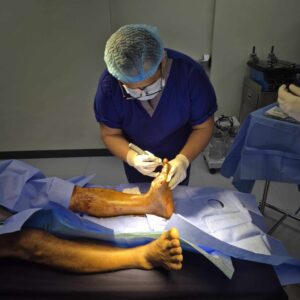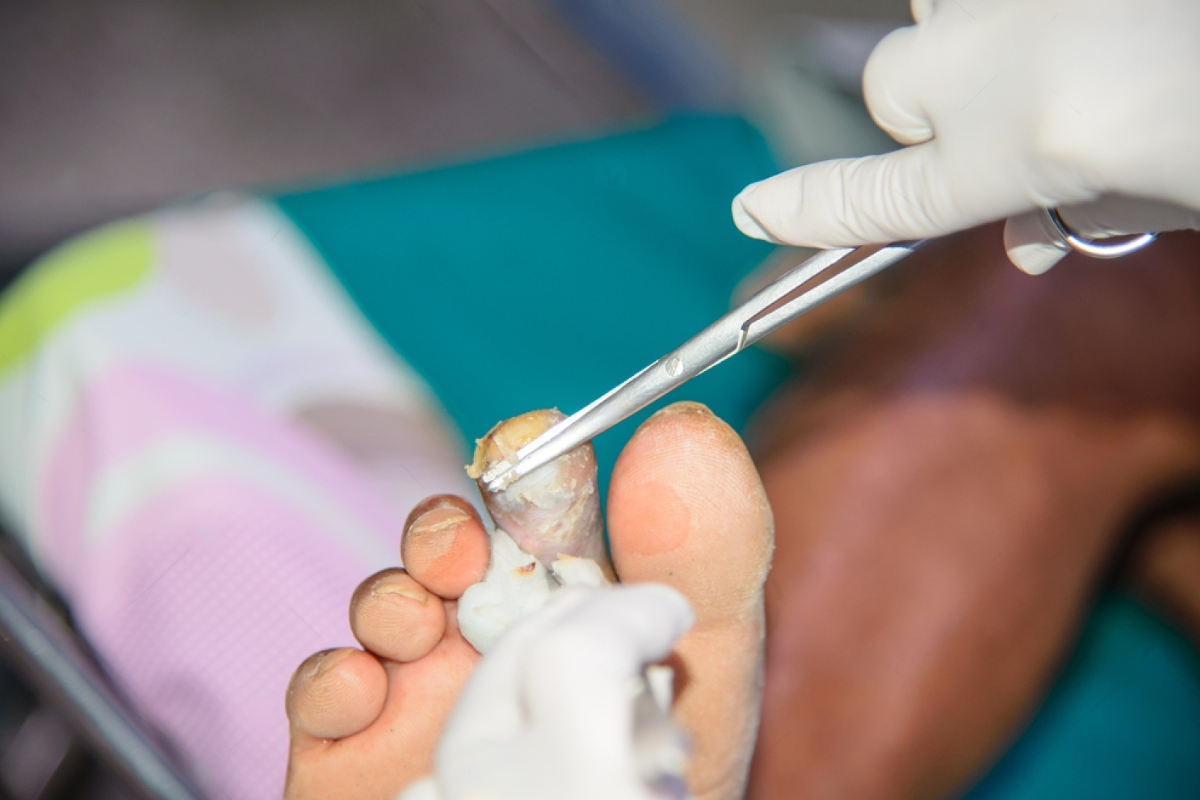Understanding Necrotic Foot and Its Impact
A necrotic foot occurs when body tissue begins to die due to poor blood supply, infection, or trauma. This condition is often linked to diabetes, peripheral artery disease, or severe injuries that restrict circulation. When tissue is deprived of oxygen and nutrients, it cannot survive, leading to necrosis. Patients may notice symptoms such as skin discoloration, persistent wounds that do not heal, foul odor, or pain that becomes worse over time. Some may also experience numbness due to nerve damage. If left unaddressed, necrotic tissue spreads quickly, leading to severe complications. Early recognition is vital because timely orthopedic treatment for necrotic foot can prevent worsening outcomes, including amputation.
Role of Orthopedic Specialists in Managing Necrotic Foot
Orthopedic specialists play a crucial role in diagnosing, treating, and managing necrotic foot conditions. Their expertise extends to the bones, joints, ligaments, and muscles, making them essential in evaluating how tissue death impacts structural integrity. In many cases, they collaborate with vascular surgeons, podiatrists, wound care specialists, and infectious disease experts to create comprehensive treatment plans. A multi-disciplinary approach ensures that both the root cause and secondary complications are addressed. Orthopedic doctors assess the extent of necrosis, determine whether bone involvement exists, and recommend treatments that preserve as much function as possible. Without specialized orthopedic care, patients risk delayed healing, recurrent infections, and reduced mobility. By integrating advanced medical knowledge with surgical precision, orthopedic specialists help patients regain hope and function.
Diagnostic Methods for Necrotic Foot
Accurate diagnosis is essential for successful orthopedic treatment for necrotic foot. Physicians begin with a detailed physical examination, looking for signs of dead tissue, infection, and impaired circulation. Medical history is reviewed to identify underlying conditions such as diabetes, vascular disease, or previous injuries. Imaging tests, including X-rays, MRIs, and CT scans, help visualize bone involvement and the depth of tissue damage. Vascular studies measure blood flow to determine if restricted circulation is contributing to necrosis. Laboratory tests may also be performed to detect infection, monitor blood sugar, and check for systemic issues. Combining these diagnostic methods allows doctors to create tailored treatment strategies. The goal is not only to remove damaged tissue but also to address the underlying causes to prevent recurrence.
Non-Surgical Orthopedic Treatment Options
For many patients, non-surgical methods are the first line of defense. Orthopedic treatment for necrotic foot may include debridement, where dead tissue is carefully removed to allow healthy tissue to heal. Specialized wound dressings that promote moisture balance and prevent infection are also applied. Antibiotics play an important role in controlling bacterial growth and preventing sepsis. In some cases, hyperbaric oxygen therapy is recommended to enhance oxygen delivery and improve healing in affected tissues. Orthopedic footwear and offloading devices are prescribed to reduce pressure on the necrotic area, giving wounds a better chance to recover. Lifestyle adjustments such as proper nutrition and blood sugar control are strongly encouraged to support healing. These combined efforts often delay or even prevent the need for surgical intervention.
Surgical Orthopedic Interventions for Necrotic Foot
When non-surgical measures are insufficient, surgical procedures may become necessary. Orthopedic surgeons are skilled in performing different types of debridement, including sharp, mechanical, and enzymatic techniques, to eliminate necrotic tissue. In severe cases, reconstructive surgery may be required to repair damaged structures and restore function. Skin grafts and flap surgeries are utilized to cover large wounds and encourage regeneration. In situations where infection spreads to the bone, partial foot amputation may be necessary to save the rest of the limb. Limb-sparing surgery is always prioritized whenever possible to maintain mobility and quality of life. With advances in surgical technology, patients now benefit from more precise techniques, shorter recovery times, and improved outcomes. Orthopedic expertise ensures that surgery is not only life-saving but also mobility-preserving.
Rehabilitation and Recovery After Treatment
The healing process does not end after surgery or wound care. Rehabilitation plays a significant role in restoring mobility and preventing long-term disability. Physical therapy helps patients rebuild strength, improve circulation, and regain balance. Orthopedic specialists often recommend custom orthotics or braces to provide support and stability during recovery. Pain management strategies, such as medications and guided exercises, make the rehabilitation process more tolerable. Patients are also encouraged to practice proper wound care at home, which helps prevent reinfection. Lifestyle changes, including smoking cessation, regular exercise, and proper diet, further support recovery. Long-term follow-ups with orthopedic teams ensure that healing progresses smoothly and that complications are addressed early.
Long-Term Management and Prevention Strategies
Preventing necrotic foot recurrence is just as important as treating the condition. Patients are encouraged to perform daily foot checks, especially those with diabetes or poor circulation. Proper foot hygiene, wearing breathable socks, and using protective footwear can help reduce risks. Blood sugar management plays a critical role in preventing tissue damage, particularly for diabetic patients. Nutrition that supports vascular health, including foods rich in antioxidants and omega-3 fatty acids, also strengthens the body’s defenses. Regular orthopedic checkups are recommended to monitor foot health and intervene before problems worsen. Patients who follow preventive care routines significantly reduce the likelihood of recurrence. By making these strategies part of daily life, individuals protect not only their feet but also their independence and overall well-being.
Potential Risks of Untreated Necrotic Foot
Ignoring necrotic foot symptoms can lead to devastating consequences. Untreated necrosis can spread quickly, destroying skin, muscle, and bone. Infections may progress to sepsis, a life-threatening condition where the infection spreads throughout the body. Patients often face an increased risk of limb amputation if necrosis is not addressed promptly. Beyond the physical effects, living with untreated necrotic foot significantly reduces mobility and quality of life. Many individuals struggle with pain, loss of independence, and psychological stress. Orthopedic treatment for necrotic foot is not only about saving a limb but also about preventing these long-term consequences. Seeking timely medical help can make the difference between recovery and permanent disability.
When to Seek Orthopedic Help Immediately
Recognizing the right time to seek orthopedic care can prevent severe complications. Symptoms such as blackened skin, foul odor, persistent wounds, or sudden swelling should be treated as emergencies. Patients with diabetes or vascular disease must be particularly vigilant, as their risks are higher. Delaying care reduces the likelihood of saving the affected limb and increases the risk of systemic infection. Orthopedic doctors are trained to intervene quickly with effective treatment strategies. Even if symptoms seem minor, early intervention provides better outcomes. Choosing orthopedic treatment for necrotic foot at the first sign of trouble offers the best chance at healing and preserving mobility.
Frequently Asked Questions (FAQ)
1. What causes necrotic foot, and who is most at risk?
Necrotic foot is commonly caused by poor blood circulation, severe infections, trauma, or complications from diabetes. Individuals with vascular disease, uncontrolled diabetes, or immune deficiencies are at higher risk.
2. How do orthopedic specialists determine the best treatment option?
Orthopedic doctors use physical exams, imaging tests, and lab results to assess tissue damage. They then recommend a treatment plan based on the severity of necrosis and overall patient health.
3. Is surgery always necessary for necrotic foot?
No, surgery is not always required. Many patients respond well to non-surgical treatments such as debridement, wound dressings, and antibiotics. Surgery is considered when tissue death is extensive or infection reaches the bone.
4. Can necrotic foot heal completely with orthopedic care?
With early intervention and proper care, many patients achieve significant healing. However, the extent of recovery depends on the severity of tissue damage and underlying health conditions.
5. What lifestyle changes can help prevent recurrence after treatment?
Daily foot care, blood sugar management, proper nutrition, wearing protective footwear, and regular orthopedic checkups are essential to prevent recurrence.











